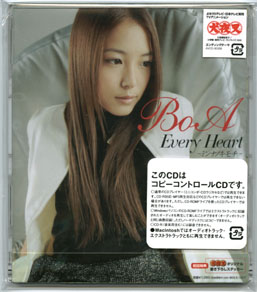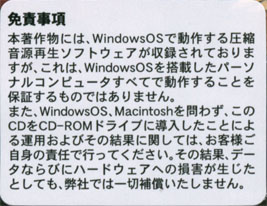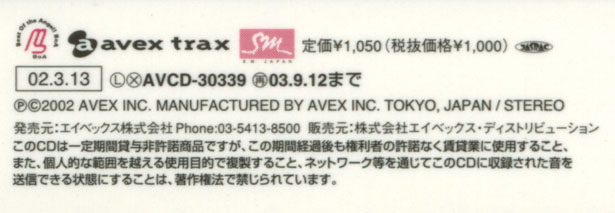
| Daryl's Library - Final Fantasy CDs |
 |
NOTE from the webmistress of Daryl's Library: The following commentary between the horizontal lines with all its text, images and other contents were taken directly from the original Tripod site on which it first appeared. I did NOT write the commentary! If you are the original creator of this page and would like me to remove this from my site, please email me and I will gladly comply.
For Avex's official description of this copy protection, click here (the site is all in Japanese). For a picture of the warning labels currently being used on Avex CDs, click here.
General explanation of copy protection: (this info taken from someplace I remember reading...) Basically, Avex has attempted to make it so that Macintosh computers won't be able to play, much less copy to MP3, a protected CD. Macs were targeted specifically because a lot of people in Japan use Macs. But the copy-protection also affects Windows machines, as you'll soon read.
However, as I and some others have found out, many Macs running newer operating systems can rip songs from Avex copy-protected CDs just fine. I don't know how Avex's technology is developing, though, so this may change in the future.
NOTE: The below text was written when Avex first came out with its copy protection, back in 2002. The information has not been updated since then. As such, the information is likely out of date or may not be applicable to newer Avex CDs, especially if the technology has changed since then.
I recently ordered two CDs from Japan -- BoA's album "Listen to My Heart", and her simultaneous single release "Every Heart - Minna no Kimochi". Since the single track is also included on the album, there was essentially no reason to get the single except for the coupling tracks, which were even more paltry than usual for singles -- a couple remixes and an instrumental track. My purchase of the single amounted to a corporate welfare payment. The least I could expect in return was to be treated with dignity.
While I was waiting for the CDs to arrive, I heard that the single was copy-protected. At first, I didn't think much of this. I wasn't going to copy the single, after all. But my attitude was to change drastically.
When the single was delivered, the first thing that leapt out were the prominent warning and disclaimer labels:



I get enough fine print in my life as it is, without having to deal with it on an audio CD as well. I resent this encroachment of disclaimers and incompatibilities on what used to be a very simple system. Intriguingly, the front warning label was stuck over a smaller label, which apparently contained the same text, but in a smaller font. I suppose Avex thought its ass was better covered by the larger, more prominent label.
Reading the various disclaimers was a sobering experience. According to them, the audio tracks would play in "most" CD players, but not computer CD-ROM drives, CD/MP3 players, or "some" players that supported CDR media. An included player application would allow Windows users to play back a compressed version of the audio, but Avex gave no guarantees that the player would work. Of course users of Macintoshes, or even Linux, were completely out of luck. And liability for hardware or software damage for the mere act of inserting the CD into a CD-ROM drive was explicitly disclaimed. Why did I, a paying customer, deserve a mangled disc that would possibly blow up any drive that it was placed in?
Anyway, curious about how the copy protection worked, I inserted it into my Pioneer DVD-ROM drive. After an unusually long mounting period, during which the drive made several unwholesome-sounding noises, the CD was finally recognized.The CD had a data track with the player application, which was set to autorun. Here's a shot of the player with all its various windows open.
In return for paying money to purchase the single, I received the privilege of listening to a 47 kbps WMA version of the songs, the only worthwhile one of which was already available in unprotected and uncompressed form on the album. The WMA tracks sounded terrible. I might have been imagining the poor audio quality (though I doubt it), or I might not have been. But that's beside the point. What was wrong was the very fact that I had to wonder whether I was hearing a full-quality version of the music or not. To add insult to injury, the writer and publisher information on these official WMAs hadn't even been entered, and the album information was completely erroneous (see picture). This was seriously shabby treatment.

Avex had apparently bloated up a 20-minute CD single to fill 800 MB on the CD. All that wasted space, and they couldn't even bump up the data rate on the WMAs to a reasonable quality.

The bloat comes from the yucca.cds file, which presumably contains the compressed audio data. This file actually has a falsified directory entry -- it's not actually that large. In reality, it is only large enough to bloat the CD out to 74 minutes -- which would still have left plenty of space for better WMAs.
Playing the audio tracks off the CD failed -- only track 1 played, and that stopped after 10 seconds. CD ripping programs failed more extravagantly. In particular, whenever I tried ripping using my old CDR drive, the system hung, forcing a reboot. Some programs refused to even try to read the disc. CloneCD appeared to make a copy of the disc, but the copy was completely unusable as it wouldn't read at all.
At this point I was fairly upset with the copy protection. Of course, I resolved to find out how it could be broken. It turned out that the copy protection scheme was called Cactus Data Shield 200 (hence the filename "Yucca"). CDS200 relied on putting corrupt TOC data in the second (data) session to confuse CD-ROM drives. Some programs, notably Feurio! and Exact Audio Copy, had special routines to deal with these corrupted TOCs, but they only worked on certain systems.
As it turned out, neither one really did what I wanted it to, but I discovered that if I ejected and reloaded the CD, the TOC detected by my DVD drive would be different every time.

Here we see that all the tracks show up as data tracks. The first three are way too short, and the fourth contains the rest of what would be the audio data.

Here only the fourth track erroneously shows up as a data track. Tracks 1 and 2 are correct, but track 3 has a negative playtime.
After ejecting and reloading about fifty times, the drive detected this TOC:
This was still not quite correct, but it was apparently close enough that Exact Audio Copy was now able to reconstruct the correct version:
This allowed me to rip the tracks to my hard drive, but Exact Audio Copy's error correction light lit up like a Christmas tree when I did so. Apparently, CDS200 CDs have substandard pressing quality (perhaps as an additional layer of "copy protection"?) The pristine, unscratched, brand-new single registered a quality of 97%, compared to 100% for the simultaneously purchased and un-copy-protected album. After several years' worth of play, dust, and scratches, the single could easily be rendered unreadable. I will make sure to burn an unprotected copy that is actually usable in all CD players.
Philips has refused to allow its familiar Compact Disc logo to be used on these substandard discs, and with good reason.

This is the Compact Disc logo.

Note its conspicuous absence on the single's packaging.
In conclusion, I will never knowingly buy a copy-protected CD again, and I recommend that you avoid them too.
Last revised by the webmistress Jan. 18, 2004